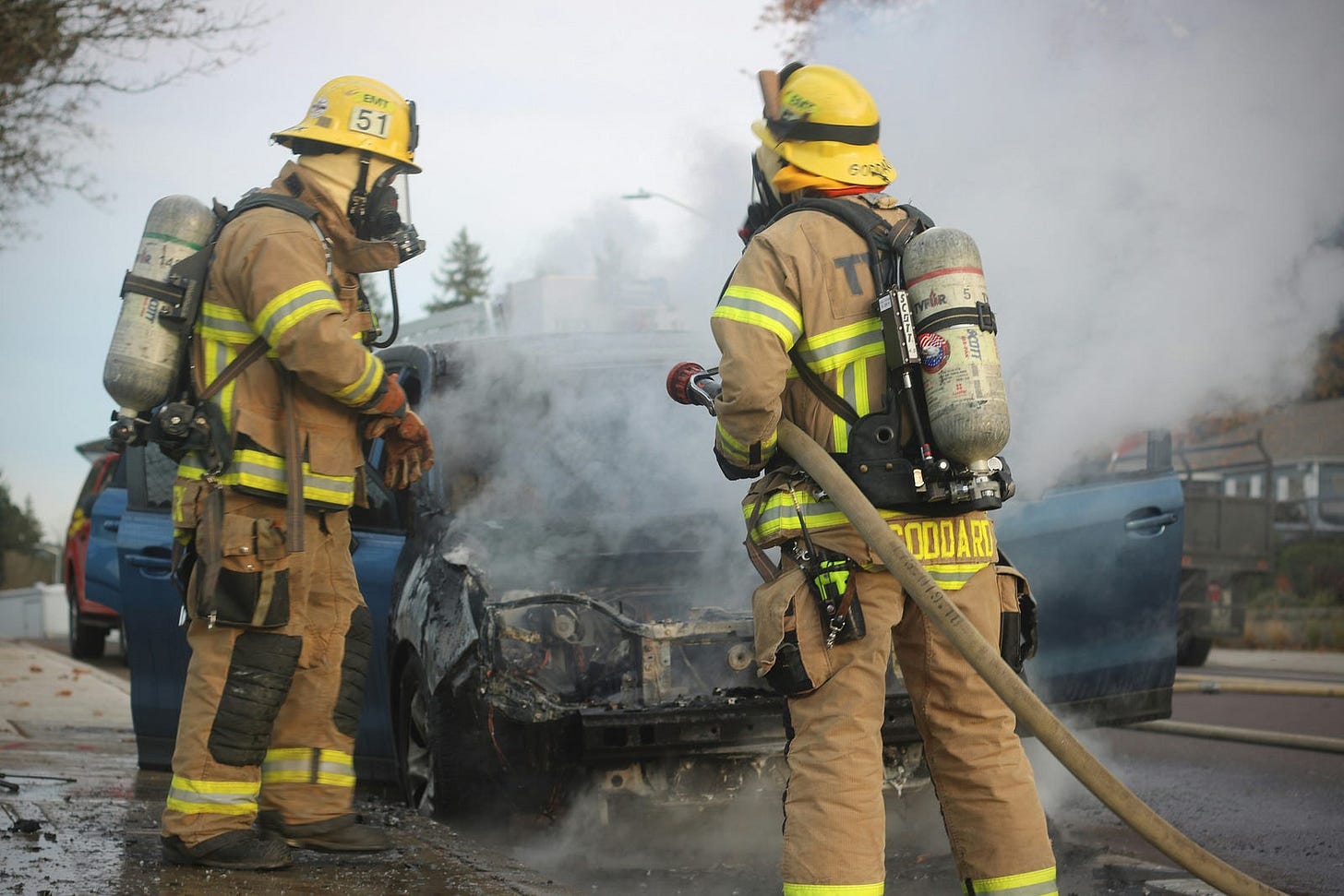Are Electric Cars Really A Fire Risk?
You might be surprised.

Last summer, a car park in Luton, UK, burst into a raging inferno out of nowhere. Social media personalities and many traditional media outlets quickly speculated the event was caused by an EV that spontaneously caught fire. Which, apparently, they always do. The fire brigade later confirmed that it was, in fact, a diesel car that started the fire. I thought this idea that EVs were a fire risk was relatively fringe until I had a recent gathering of friends and family in which they asked me why EVs are better, and almost every single one of them said something along the lines of “Yeah, that all well and good, but they catch fire constantly!” So, is there any truth to this notion?
Well, to put it bluntly, no.
A Swedish Civil Contingencies Agency study recently found that EVs are 20 times less likely to catch fire than petrol or diesel cars. Of the 611,000 EVs on their books in 2022, only 25 caught fire, a rate of 0.004% catching fire each year. Meanwhile, the 4.4 million combustion cars on their books suffered 3,400 fires in 2022, or a rate of 0.08% catching fire each year. A US insurer found that EVs suffer 25 fires per 100,000 sold, while combustion vehicles had 1,530 fires per 100,000 sold, suggesting that EVs are over 60 times less likely to catch fire. EV FireSafe has verified that fewer than 500 EV battery fires have ever happened with the 20 million EVs sold worldwide, suggesting that EV fires are actually 80 times rarer than combustion engine fires.
Basically, no matter how you analyse the data, EVs catch fire way less than combustion engine vehicles. It might not be that surprising, considering one uses explosively flammable liquid and the other electrons as fuel.
So, why this incredibly perfuse false narrative? When EVs started to go on sale twenty years ago, the media loved the attention they got slandering them. One of their favourite ways to make EVs seem terrible was to hyperfocus on occasions when an EV did catch fire, and this has stuck in our heads. Over the past few years, this has been amplified by battery-powered consumer goods having numerous issues with explosively flammable batteries. I can think of many times when vapes, smartphones, and hoverboards made national headline news for starting fires. Sadly, these devices were fitted with cheap and unsafe batteries and battery management systems, which caused these issues. Such issues can’t happen with automotive batteries, which are held to far higher safety standards. Nonetheless, it seems our collective consciousness has associated teenagers getting third-degree burns from their vapes exploding in their pockets with EVs suffering the same issue.
Now, it’s important to say that on the incredibly rare occasions that EVs do catch fire, it is worse than when a combustion engine vehicle bursts into flames. You see, materials within the battery are highly flammable, and the phenomenon known as thermal runaway means the batteries can self-heat themselves to the combustion point. In other words, you can’t just rock up and extinguish an EV battery fire quickly, and you definitely can’t use water or fire extinguishers to fight it. Instead, novel fire blankets are being rolled out that can cover an entire EV and starve the battery fire of oxygen without needing a liquid or gas supply. This slows down the thermal runaway and allows the battery to cool gradually, and after a while, the battery’s temperature dips below combustion, and the fire can’t return.
But soon, EV fires will be even rarer, and you will be able to fight them just like ordinary fires. LFP cells aren’t combustible at all; you can even drive a nail through the cell and heat it to hundreds of degrees Celsius without it catching fire, and they don’t suffer from anywhere near as much thermal runaway. The same can be said of sodium-ion batteries and even solid-state batteries. These three technologies are set to replace the current lithium-ion batteries fitting to most EVs over the next decade, as they offer better prices and specs. So not only are EV fires really not a problem today, but they are set to become even less of a problem over the next few years.
Thanks for reading! Content like this doesn’t happen without your support. So, if you want to see more like this, don’t forget to Subscribe and follow me on BlueSky or X and help get the word out by hitting the share button below.
Sources: Fleet News, Top Gear, Electric Fire Blanket, Science Direct

